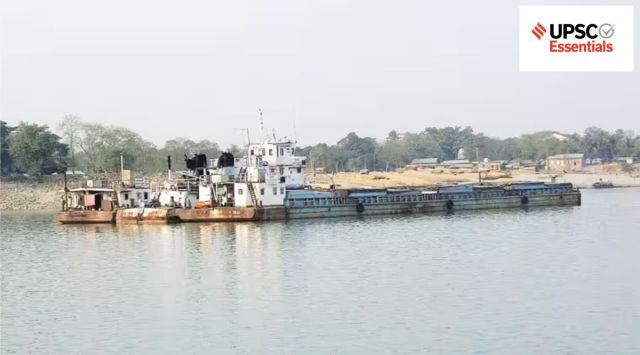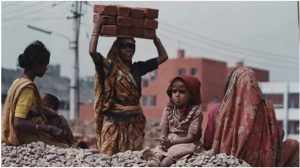UPSC Essentials | Mains answer practice : GS 1 (Week 9)
UPSC CSE Mains 2023 season has begun. Are you ready for it? Here are questions from GS paper 1 for this week with essential points as the fodder for your answers.
 Attempt questions on Indian history and Indian geography. Find question on inland water transport in our article today. (Image Source: File)
Attempt questions on Indian history and Indian geography. Find question on inland water transport in our article today. (Image Source: File) 🚨 This story is part of our special initiative for UPSC and other competitive exams. Look out for UPSC KEY on weekdays and UPSC Essentials everyday, Weekly news express with MCQs, Key Terms of the past week, Quizzes as well as The Indian Express 360° Upsc Debate, Society & Social Justice, UPSC Mains Practice, Art and Culture with Devdutt Pattanaik, UPSC Ethics Simplified, Experts Talk, and more. 🚨
UPSC Essentials brings to ytoou its new initiative for the practice of Mains answer writing. Mains Answer Writing will cover essential topics of static and dynamic parts of the UPSC Civil Services syllabus covered under various GS papers. This answer-writing practice is designed to help you as a value addition to your UPSC CSE Mains. We will cover one new subject four days in a week. Attempt today’s answer writing on questions related to topics of GS-1 to check your progress.
Dear Aspirants,
Thank you for joining us for LIVE sessions. You will be happy to know that we will be LIVE every week on Wednesdays, take up your queries, provide you with cues from the news, and discuss relevant themes revolving around news and UPSC preparation in general.
This week’s most popular question: Manipur issue – What and how to study?
We will take up more questions too. You can send your queries at manas.srivastava@indianexpress.com or join Telegram: The Indian Express UPSC Hub or ask me Live! at 8 PM on July 26.
QUESTION 1
Discuss the role of women in the freedom struggle for Independence.
QUESTION 2
What are the challenges for inland water transport in India?
General points on the structure of the answers
Introduction
— The introduction of the answer is essential and should be restricted to 3-5 lines. Remember, a one-liner is not a standard introduction.
— It may consist of basic information by giving some definitions from the trusted source and authentic facts.
Body
— It is the central part of the answer and one should understand the demand of the question to provide rich content.
— The answer must be preferably written as a mix of points and short paragraphs rather than using long paragraphs or just points.
— Using facts from authentic government sources makes your answer more comprehensive. Analysis is important based on the demand of the question, but do not over analyse.
— Underlining keywords gives you an edge over other candidates and enhances presentation of the answer.
— Using flowcharts/tree-diagram in the answers saves much time and boosts your score. However, it should be used logically and only where it is required.
Way forward/ Conclusion
— The ending of the answer should be on a positive note and it should have a forward-looking approach. However, if you feel that an important problem must be highlighted, you may add it in your conclusion. Try not to repeat any point from body or introduction.
— You may use the findings of reports or surveys conducted at national and international levels, quotes etc. in your answers.
Self Evaluation
— It is the most important part of our Mains answer writing practice. UPSC Essentials will provide some guiding points or ideas as a thought process that will help you to evaluate your answers.
THOUGHT PROCESS
You may enrich your answers by some of the following points
QUESTION 1: Discuss the role of women in the freedom struggle for Independence.
Introduction:
A simple introduction to this answer can revolve around a general statement about role of women in history.
— The entire history of the freedom movement is filled with the saga of bravery, sacrifice and political sagacity of hundreds and thousands of women in our country.
— The women were not merely passive workers following in the footsteps of celebrated men; they were active revolutionaries, taking up arms, launching underground organisations, publishing anti-British literature, and being subjected for years to torture and imprisonment.
(Source: magazines.odisha.gov.in)
Body:
You may incorporate some of the following points in the body of your answer:
Role of women in the freedom struggle for Independence
Before and during the revolt of 1857
— The participation of women in the struggle began as early as 1817 when Bhima Bai Holkar fought against British Colonel Malcolm and defeated him in guerilla warfare.
— The queen of the princely state of Jhansi, Rani Laxmibai is known for her role in the First War of India’s Independence in 1857. She was the second wife of the ruler of Jhansi Raja Gangadhar Rao who protested against the ‘Doctrine of Lapse’. She refused to surrender to Jhansi and fought bravely attired as a male during the Revolt of 1857 and died on the battlefield fighting the British forces.
— Hazrat Mahal Begum was the wife of the deposed ruler of Lucknow who actively took part in the revolt of 1857.
After the revolt of 1857
— Sarojini Naidu holds pride of place among women freedom fighters of India. She was responsible for awakening the women of India. She was the first woman President of the Indian National Congress in 1925 at the Kanpur Session.
— Aruna Asaf Ali played a leading role during the Quit Indian Movement. She unfurled the National Flag at the Gowalia Tank maidan in Bombay to signify the commencement of the Quit India Movement.
— Rani Gaidineliu was a prominent Naga nationalist woman leader from Manipur who took over the movement of Naga nationalists against the British.
— Kalpana Dutta was another prominent woman revolutionary leader who was influenced by the revolutionary idea of Surya Sen.
— Madam Bhikaji Cama was influenced by Dadabhai Naoroji and served as an inspiration to Indian youth in the United Kingdom. She raised the first National Flag at the International Socialist Conference in Stuttgart (Germany) in 1907, founded the Free India Society, and launched the periodical ‘Bande Mataram’ to propagate her revolutionary ideas.
— Sucheta Kriplani was an ardent nationalist with a socialistic orientation. She was a close associate of Jai Prakash Narayany who actively participated in the Quit India Movement.
— Raj Kumari Amrit Kaur was a close follower of Gandhiji from 1919 onwards. She actively participated in the 1930 Salt Satyagraha and the Quit India Movement. She became the first Health Minister in post-independent India.
— Annie Besant, who was born in Ireland, was a fervent supporter of India’s freedom struggle. In 1916, she launched the Madras Home Rule League. In addition, she formed the Theosophical Society of India. She served as the first woman president of the Indian National Congress in Calcutta in 1917.
(Sources: Women heroes of India’s freedom struggle, mentioned by PM in his I-Day speech, magazines.odisha.gov.in)
Points to Ponder
Role of Women in non-cooperation Movement
Role of women in the civil disobedience movement.
Related Previous Year Question
The women’s questions arose in modern India as a part of the 19th-century social reform movement. What were the major issues and debates concerning women in that period? (2017)
Discuss the role of women in the freedom struggle especially during the Gandhian phase. (2016)
QUESTION 2: What are the challenges for inland water transport in India?
Introduction:
A simple introduction to this answer can revolve around a general statement about inland water transportation in India.
— India features a vast network of inland waterways, including rivers, canals, backwaters, and creeks. When compared to other developed countries, freight transportation by waterways is vastly underutilized in the country. Most of India’s hinterland connection is provided by road and rail, with domestic waterways—coastal shipping and inland waterways—playing a minor role.
— Waterways are found to be cost-effective as well as an environmentally friendly means of transporting freight. In India, Inland Water Transport (IWT) has the potential to supplement the over-burdened railways and congested roadways.
(Source: shipmin.gov.in)
Body:
You may incorporate some of the following points in the body of your answer:
— In 2016, the government notified 111 inland waterways as National Waterways of India under the National Waterways Act, 2016. Of these, 13 National Waterways are operational for shipping and navigation and cargo/passenger vessels are moving on them.
— The Inland Waterways Authority of India under the Ministry of Shipping is developing the National Waterways for commercial navigation, including with assistance from the World Bank.
Challenges for Inland water transportation in India
— The primary requirement for inland transportation is adequate water flow and it has been reduced over the years due to industrial and agricultural wastes and more likely due to habitation.
— Siltation, which is caused by deforestation and erosion.
— There is a shortage of inland water transportation (IWT) vehicles.
— Lack of skills and technology adoption.
— If the water depth of the channel is inadequate, then it will not allow the larger vehicles to cross.
— There are multiple bridges with low vertical clearance which hinders inland water transportation.
— There are various other challenges in the implementation of the inland water transportation system of India such as delays in land acquisition, difficulties in the disposal of dredged material, delays in project execution, and poor fund utilisation.
(Sources: Inland Water Transport Development: In the backwaters of Kerala lies the key for its growth by RM Nair, ncert.nic.in)
Conclusion:
Your conclusion should be short.
— Inland Water Transport (IWT) is the most economical mode of transportation, especially for bulk cargo like coal, iron ore, cement, food grains and fertilizer.
— Efficient planning of fairway or the channel, terminals and intermodal connectivity, vessels of optimum dimensions and utility and navigational aids for safe and round-the-clock navigation are needed to make the IWT mode competitive.
— In handling cargo through waterways, Gujarat stands only second to Maharashtra which transported 178.59 million tonnes of cargo since 2016-17.
Points to Ponder
National Waterway of India
Initiatives for the growth of traffic on national waterways
Related Previous Year Question
Enumerate the problems and prospects of inland water transport in India. (2016)
Previous Mains Answer Practice
UPSC Essentials: Mains answer practice — GS 1 (Week 7)
UPSC Essentials: Mains answer practice — GS 1 (Week 8)
UPSC Essentials: Mains answer practice — GS 2 (Week 8)
UPSC Essentials: Mains answer practice — GS 2 (Week 9)
UPSC Essentials: Mains answer practice — GS 3 (Week 8)
UPSC Essentials: Mains answer practice — GS 3 (Week 9
Post your inputs and answers to points to ponder in the comment box below and engage with other aspirants too. All the best!
The UPSC Essentials Indian Express is now on Telegram- Indian Express UPSC Hub. Click here to join our YouTube channel and stay updated with the latest updates.
UPSC Magazine

Read UPSC Magazine
- 01
- 02
- 03
- 04
- 05































